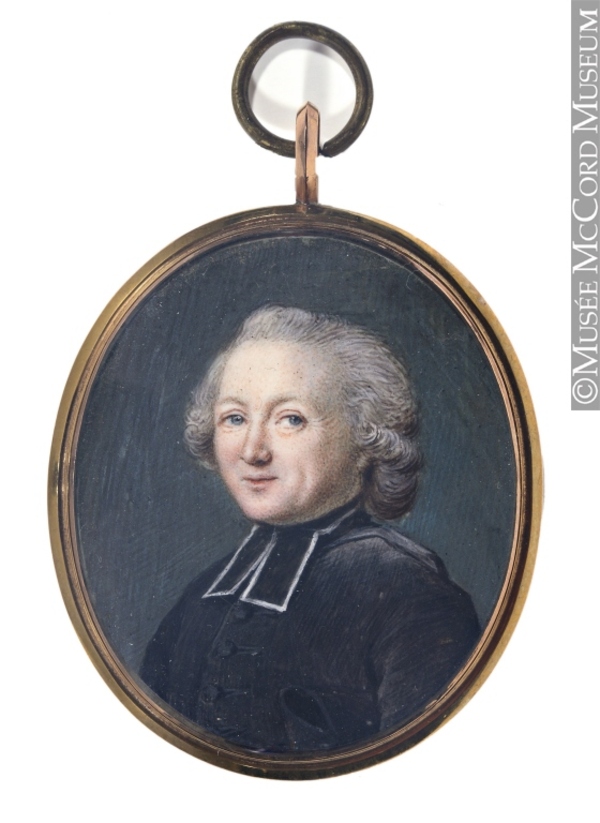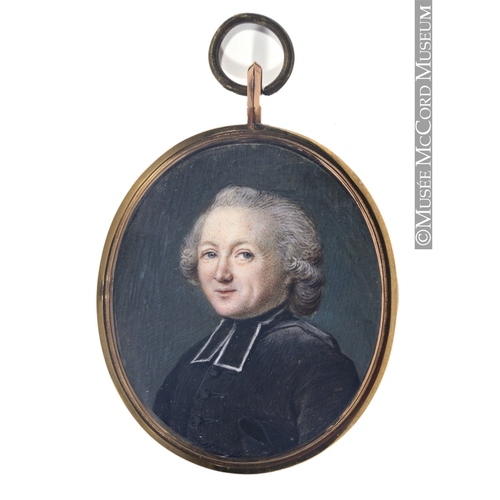
Source: Link
LA CORNE DE CHAPTES, JOSEPH-MARIE (Jean-Marie) DE, parish priest, ecclesiastical councillor, dean of the chapter, and vicar general; b. apparently at Contrecœur (Que.), son of Jean-Louis de La Corne* de Chaptes and Marie Pécaudy de Contrecœur; he is believed to have been baptized at Verchères on 2 Nov. 1714; d. 7 Dec. 1779 at Maubec (Méobecq, dept of Indre), France.
Having entered the Séminaire de Québec on 1 May 1730 Joseph-Marie de La Corne de Chaptes received the tonsure from Bishop Dosquet on 6 May 1735. Three years later, the bishop being absent from the colony, La Corne had to go to France to be ordained; he was received into the priesthood at Rennes in the autumn of 1738. On his return to the colony the following year, he was immediately named parish priest at Saint-Michel (Saint-Michel-de-Bellechasse), and there with the parishioners’ agreement built a stone presbytery.
In July 1747 Bishop Pontbriand [Dubreil*] made La Corne a canon of the cathedral of Quebec and thought of him as a replacement for ecclesiastical councillor François-Elzéar Vallier* on the Conseil Supérieur. The bishop observed that “he has intelligence and talent and is a man of good family.” On 25 Aug. 1749 the canon was appointed to the council. The experience he gained there in legal matters, combined with what he had learned as treasurer of the chapter, a position he had been holding for some time, was subsequently of great service to him. Indeed, in 1750 he was delegated by his colleagues in the chapter to go to France to defend their interests in the lawsuit about the conferring of the charge of the parish of Quebec which they had brought against the seminary and in which Canon René-Jean Allenou* de Lavillangevin played a leading role for the chapter [see also Jean-Félix Récher*]. This protracted suit, which went on until after the conquest, would summon up all La Corne’s zeal and talent.
In Paris the chapter of Quebec had already had a representative for some years in Canon Pierre Hazeur de L’Orme. La Corne thought his visit would be brief and hoped that, with the lawsuit under way, he would be able to return to Canada before the end of 1751 leaving Hazeur with power of attorney. On arrival he consulted lawyers who concluded that the chapter’s requests were well grounded. He then harassed the offices of the administration at Versailles with representations but had little success. Believing, however, that his presence was no longer necessary in Paris, he decided to return to Canada in the spring of 1751. On his way he stopped at the abbey of Saint-Pierre in Maubec, a benefice of the chapter, to assess the state of its premises. When he reached La Rochelle, he learned that the Séminaire des Missions Étrangères in Paris had undertaken to delay the legal proceedings by refusing to recognize the validity of Canon de L’Orme’s power of attorney. Reluctantly La Corne returned to the capital, where he again embarked, to no purpose, on a round of representations. In a letter to Canon Lavillangevin on 19 June 1751 he listed the connections and the line of action through which he intended to win the favours of those in high office; in the end these dealings were of no use. Incidentally La Corne seems to have exercised restraint in using the funds put at his disposal for his upkeep, but the lawsuit, now getting bogged down – in particular, in May 1753 the judge in charge of the inquiry died of smallpox – would prove expensive for the chapter of Quebec. Because of de L’Orme’s ill health, La Corne also attended to the administration of Maubec. He did not, however, lose hope of returning to Canada, although at the Paris seminary it was being said that he was prolonging the lawsuit to extend his stay in France.
La Corne informed his colleagues in a letter dated 26 Feb. 1755 that he had received royal appointment as dean of the chapter. The following year the chapter put him officially in charge of the administration of the Maubec abbey and in 1757 Hazeur’s power of attorney was cancelled in favour of La Corne. De L’Orme expressed some regret about these decisions: “I do not think [he] is as skilled yet as I can be.” La Corne kept up the struggle over the parish of Quebec, preparing memoir after memoir. In 1759 the king gave him the abbey of L’Étoile, in the diocese of Poitiers ten leagues from Maubec. Beginning that year, the year of the siege and capitulation of Quebec, La Corne attempted to help his colleagues in Quebec as much as he could; he lent them his income as dean and his canon’s prebend and agreed to allow them to draw a bill of exchange on him for 5,000 livres.
The loss of Canada gave a new direction to the career of La Corne. Until his appointment as vicar general on 30 Sept. 1760, he had attended to the lawsuit in Paris during the winter and in the summer had travelled to and fro between his abbeys. In 1762 he wanted to be relieved of his duties as the chapter’s agent; he felt that two canons from Quebec who had sought refuge in France in the autumn of 1759, Gilles-Louis Cugnet and Charles-Ange Collet *, would be capable of succeeding him. But his colleagues, who were satisfied with his services, increased his responsibilities; on 1 Oct. 1761 the chapter appointed him vicar general for Louisiana and the Mississippi region.
Bishop Pontbriand’s death in June 1760, at a dramatic moment in the history of the Canadian church, raised the problem of the succession to the bishopric. When the treaty of Paris was signed in February 1763, Canon La Corne went to London to plead for the maintenance of the Catholic hierarchy. He first called upon Lord Shelburne, the president of the Board of Trade, and presented him with a memoir in which he concluded that election of a bishop by the chapter would be the solution most acceptable to the British government. This solution was adopted in August 1763; the chapter of Quebec then hastened to elect Canon Étienne Montgolfier as bishop, and it appointed La Corne his “special procurator to report the above-mentioned election” to the authorities in London. In the spring of 1764 Britain indicated its willingness to turn a blind eye to Montgolfier’s appointment, on condition that he bear the title of “Supérieur du Clergé.” But Governor Murray categorically refused the appointment and put forward the name of Canon Jean-Olivier Briand. In March 1766 Briand was consecrated bishop in the château of Suresnes (dept of Hauts-de-Seine), France; La Corne’s negotiating for appointment of a bishop was finally crowned with success. Briand had recognized the major role played by the canon in the affair; he had indeed claimed that “If there is a bishop, it is he to whom we shall owe it.”
In a letter dated 29 March 1766 La Corne announced the good news to his colleagues in Quebec. He also informed them that the king of France was taking the Maubec abbey away from them to give it to him personally, on condition that he pay his colleagues who were in France – canons de L’Orme, Jean-Pierre de Miniac, and Joseph-Ambroise Gaillard – an annual pension of 400 francs each.
La Corne continued, however, to represent the chapter in Paris, and in its name he attended to various financial matters. On 21 Sept. 1767 Briand appointed him vicar general, and in July 1770 gave him the task of carrying out with the papal nuncio in Paris all the steps needed to obtain bulls for Bishop Louis-Philippe Mariauchau d’Esgly, the new coadjutor; La Corne complied, even though his health was not good that year. In a letter on 15 March 1770 he offered his resignation as dean, asking that he be allowed to retain the honorary title since he did not want to sever his links with the chapter. This request for permission to resign was refused. His final years, marked by illness and infirmity, were spent mainly in Berry. He died of pneumonia at the Maubec abbey on 7 Dec. 1779.
A man of great energy, who was not always easy to get along with, Canon La Corne was an effective agent for the Canadian church, both in London and in Paris, and one of our great diplomats.
AAQ, 12 A, B, 312; C, 56; 20 A, I, 43, 44, 103, 153; 22 A, II, 688; 10 B, 167v, 168, 193, 193v, 194, 200, 218, 218v, 219, 220, 222, 227, 241, 241v, 244, 248v, 250, 261; 11 B, II, 453; V, 99, 101, 112; VI, 59; VII, 1–77, 87; VIII, 37, 48; X, 28, 49, 53; 1 CB, VI, 18, 19; CD, Diocèse de Québec, I, 58, 59; 91 CM, I, 102; 60 CN, V, 19; VI, 18, 22. AD, Indre (Châteauroux), Archives de l’abbaye de Méobecq, H281-H324; État civil, Méobecq, 7 déc. 1779. ASQ, Chapitre, 50, 85, 132, 258; Évêques, nos. 88, 138, 146, 147; Fonds Viger-Verreau, Sér. O, 035, p.18; Lettres, M, 121, 122, 122a, 129; P, 24; S, 48, 92, 169; mss, 13, 18 oct. 1779; Polygraphie, VII, 2, 3, 4, 9; XIII, 24; XVII, 4; Séminaire, 14/6, no.11; 14/7, nos.2, 3, 14; 75, no.58. La Rue, “Lettres et mémoires,” ANQ Rapport, 1935–36, 323, 331, 345, 388, 402; 1936–37, 398, 414, 459; 1937–38, 248–50. Allaire, Dictionnaire, I, 289. Caron, “Inv. de la corr. de Mgr Briand,” ANQ Rapport, 1929–30, 47, 61, 63–64, 71, 104, 106. Le Jeune, Dictionnaire, II, 18–21. P.-G. Roy, Inv. jug. et délib., 1717–60, V, 125; Inv. ord. int., II, 283. Henri Têtu, Notices biographiques: les évêques de Québec (Québec, 1889), 272, 359. A.-H. Gosselin, L’Église du Canada après la Conquête, I, 2, 64, 69, 72, 77, 79, 81, 83, 87, 95–96, 115, 120–21, 124, 127–32, 148, 151, 156, 158–59, 194–96, 204, 208–9, 403; II, 118, 246; L’Église du Canada jusqu’à la Conquête, II, 159, 330; III, 76, 106–7, 124–25, 168, 248, 253, 271–72, 280, 290–92, 297–304, 350, 462. Lemieux, L’établissement de la première prov. eccl., 3–9. M. Trudel, L’Église canadienne. Lionel Groulx, “Le conflit religieux au lendemain de 1760,” SCHÉC Rapport, 7 (1939–40), 13, 18, 23. Arthur Maheux, “Difficultés religieuses après la cession,” SCHÉC Rapport, 14 (1946–47), 20. J.-E. Roy, “Les conseillers au Conseil souverain de la Nouvelle-France,” BRH, I (1895), 182. P.-G. Roy, “Les conseillers clercs au Conseil souverain de la Nouvelle-France,” BRH, XXII (1916), 352. Têtu, “Le chapitre de la cathédrale,” BRH, XIII-XVII.
Cite This Article
Jean-Guy Pelletier, “LA CORNE DE CHAPTES, JOSEPH-MARIE (Jean-Marie) DE,” in Dictionary of Canadian Biography, vol. 4, University of Toronto/Université Laval, 2003–, accessed December 20, 2024, https://www.biographi.ca/en/bio/la_corne_de_chaptes_joseph_marie_de_4E.html.
The citation above shows the format for footnotes and endnotes according to the Chicago manual of style (16th edition). Information to be used in other citation formats:
| Permalink: | https://www.biographi.ca/en/bio/la_corne_de_chaptes_joseph_marie_de_4E.html |
| Author of Article: | Jean-Guy Pelletier |
| Title of Article: | LA CORNE DE CHAPTES, JOSEPH-MARIE (Jean-Marie) DE |
| Publication Name: | Dictionary of Canadian Biography, vol. 4 |
| Publisher: | University of Toronto/Université Laval |
| Year of publication: | 1979 |
| Year of revision: | 1979 |
| Access Date: | December 20, 2024 |



